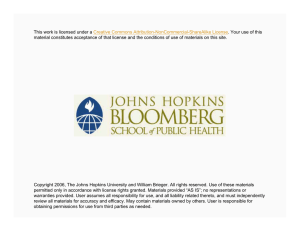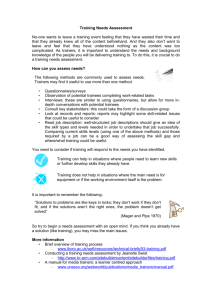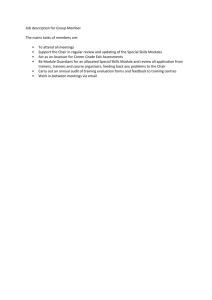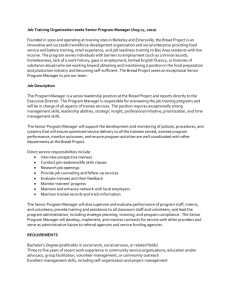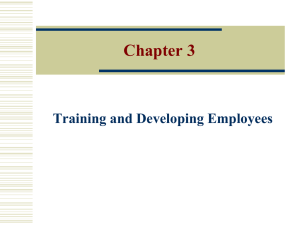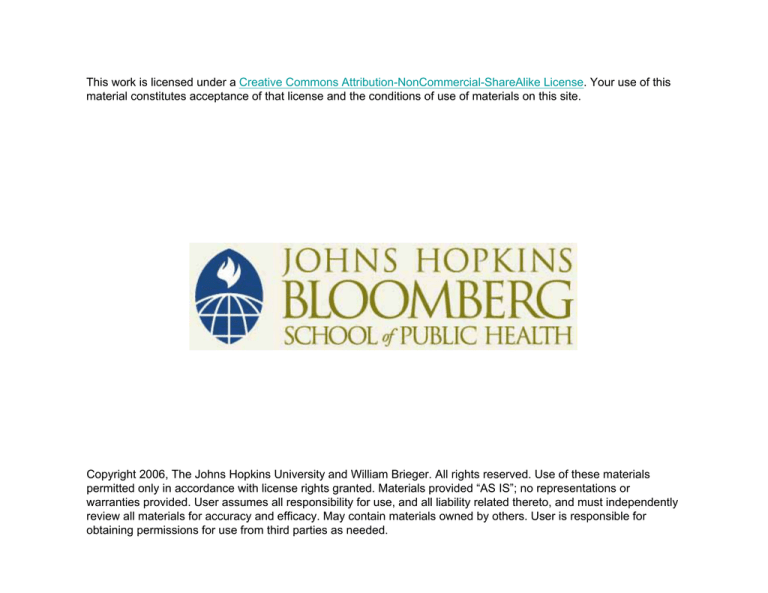
This work is licensed under a Creative Commons Attribution-NonCommercial-ShareAlike License. Your use of this
material constitutes acceptance of that license and the conditions of use of materials on this site.
Copyright 2006, The Johns Hopkins University and William Brieger. All rights reserved. Use of these materials
permitted only in accordance with license rights granted. Materials provided “AS IS”; no representations or
warranties provided. User assumes all responsibility for use, and all liability related thereto, and must independently
review all materials for accuracy and efficacy. May contain materials owned by others. User is responsible for
obtaining permissions for use from third parties as needed.
Monitoring Implementation
William Brieger, MPH, CHES, DrPH
Johns Hopkins University
Section A
What Is Monitoring?
Why Monitor?
While a training event should be planned and
structured in advance:
It should also be continuously responsive to the
unanticipated needs of individual trainees and to
unanticipated circumstances
Speakers may not show, trainees may need a
session repeated, a trainee resource may be
discovered, etc.
3
Monitoring Involves Responsiveness
Recognition and some accommodation of trainees’ initial
expectations is especially important in setting the tone of
the training event
Responsiveness to comfort level is also important
If trainees express discomfort with the idea of, for
example, role plays, adapt and turn this to a case
study
4
Monitoring Is Process Evaluation
As the training progresses we monitor:
Adequacy of materials, supplies, and logistical
arrangements
Extent to which planned activities are implemented
Appropriateness of activities to trainee background
Levels of interest and participation
Trainee response to technical inputs
5
Using Process Evaluation
Regular trainers’ and/or training committee meetings
should be held
Meetings should take place at a time when decisions can
have good effect
In the evening after a day’s session
In the morning before the next session begins
Informal meetings over lunch and during breaks may be
needed
6
Trainers’ Meetings
Review information
gathered by a
designated observer
Discuss end-ofsession review
activities to see
whether trainees
grasped content
Photo by John Oribhaboise
Determine how to respond to suggestions from trainees
Continued
7
Trainers’ Meetings
Make decisions, assign
responsibility
Follow up at next trainers’
meeting
Photo by John Oribhaboise
8
Timely Feedback
Planning and structuring of activities allow monitoring
while the training is still going on—what to expect and
when things do not go as planned
Trainers/trainees need to know whether to:
Go ahead, repeat, or reorganize parts of the
training program
Provide more materials, change the speaker, etc.
9
“Immediate” Results
This “knowledge of results” is a crucial aspect of
reinforcement for trainer and trainee—and is the basis
for rational decision-making
However, to be most effective, feedback must be
immediate
In addition, trainees need to be involved in administering
monitoring tools
10
Achieving Immediacy
At least one
member of the
training team
should be designated
as the observer for
each session
He/she should take
good notes
Even so, all trainers, whether they are talking,
demonstrating or not, should keep an eye and ear out for
problems
11
Observer’s Checklist
Keeping to time limits
Adequacy of resources
from chalk to handouts
Attention level—alertness,
chatting, doing other work,
snacking, etc.
Attendance level, including lateness or early departures
Continued
12
Observer’s Checklist
Amount of participation
Risk, comfort with activities and topics
Trainer behavior—delivery style, clarity, inclusiveness,
being bossy
Trainee relationships—arguments, avoidance
Space and environment—ease of movement,
temperature, light
13
Using Information
Some observations require quick intervention
Cutting off lengthy talks, discussions
Solving disputes between trainees
Adjusting the room temperature
Continued
14
Using Information
All observations should be shared at the daily
trainers meeting
What could we have done better?
How can we make corrections for tomorrow?
15
Section B
Monitoring Content and Process
Monitoring ‘R’ Us: Silberman’s 4 Rs
Reviewing the content of a day’s work or a whole session
should be done with the participants
Recall
Reminisce
Rehearse
Reconsider
17
Structure Review Times
Recall: the simplest way to review information and ideas
covered
Quiz games, question and answer, team
competitions
Reminisce: participants talk about what they have been
through together
Share thoughts about how the experiences
affected them personally and professionally
18
Reviewing
Rehearse: somewhat like return demonstration,
performing skills they have learned
Role play, taking turns performing skills
Reconsider: seeking opinions about the training topic
and experience
Discuss changes in attitude, perception
Especially if content challenged traditional ways of
thinking and doing things
19
Use Content Review
Trainers meetings will discuss content review activities
and determine whether:
Time was adequate to cover content
Content was grasped
Content was too simple or complex
Decisions should be made whether to repeat sessions,
clarify content, present in a different format
20
Reviewing the Process
At the beginning of each training day, obtain feedback
from the trainees about the previous day’s activities
This can be a “wishes and pluses” session
A chart like the one on the next slide should be prepared
and posted on flipchart paper or a chalkboard
One of the trainees should lead this session and write
participants’ answers on the chart
21
Pluses and Minuses
+ Pluses +
+
+
+
The guest speaker had
useful handouts
Group tasks were clear
and interesting
Field visit clarified many
points
– Minuses –
— The speaker spoke too
fast
— Break time was late and
too short
— Not everyone at the field
site expected us
— We needed more note
paper
22
Getting Feedback
The trainer first greets the group and explains that
this short session is aimed at finding out:
What trainees thought went well (pluses) the
previous day
What they “wish” had been done differently or
better
Continued
23
Getting Feedback
Trainees then comment on any aspect of the program
From training content, style of presentation,
adequacy of break time, and quality of lunch
24
Everyone Gives Input
Just as in brainstorming
All comments should be made and written down
before any are criticized or discussed
After the full list is made, trainees should offer
suggestions to address wishes
25
Use the Information
After trainees have had a chance to comment, trainers
can indicate how they will respond to the trainees’ needs
If possible, during the remaining time of the
workshop
The trainers should also review the list at a training
meeting at the end of the day
Discuss how well they responded to the “wishes”
26
The Suggestion Box
Trainees need multiple ways
of giving input
Some may be shy during
pluses and wishes sessions
An accessible and secure
suggestion box may be an alternative
The trainers should review suggestions daily
27
Summary
Monitoring ensures that the training goes as planned
and that learning is occurring
Immediate feedback is needed through observation
Content can be reviewed in daily sessions
The process can also be checked through direct trainee
feedback
Continued
28
Summary
The training committee
should use the information to
ensure training objectives are
met
This requires flexibility to
change the schedule and
activities
Changes need to be
communicated effectively
Copyright 2005, Bill Brieger and The Johns Hopkins University. All rights reserved. Use of these materials
permitted only in accordance with license rights granted. Materials provided “AS IS”; no representations or
warranties provided. User assumes all responsibility for use, and all liability related thereto, and must
independently review all materials for accuracy and efficacy. May contain materials owned by others. User is
responsible for obtaining permissions for use from third parties as needed. Unless otherwise stated, all photos are
the property of Bill Brieger.
29

